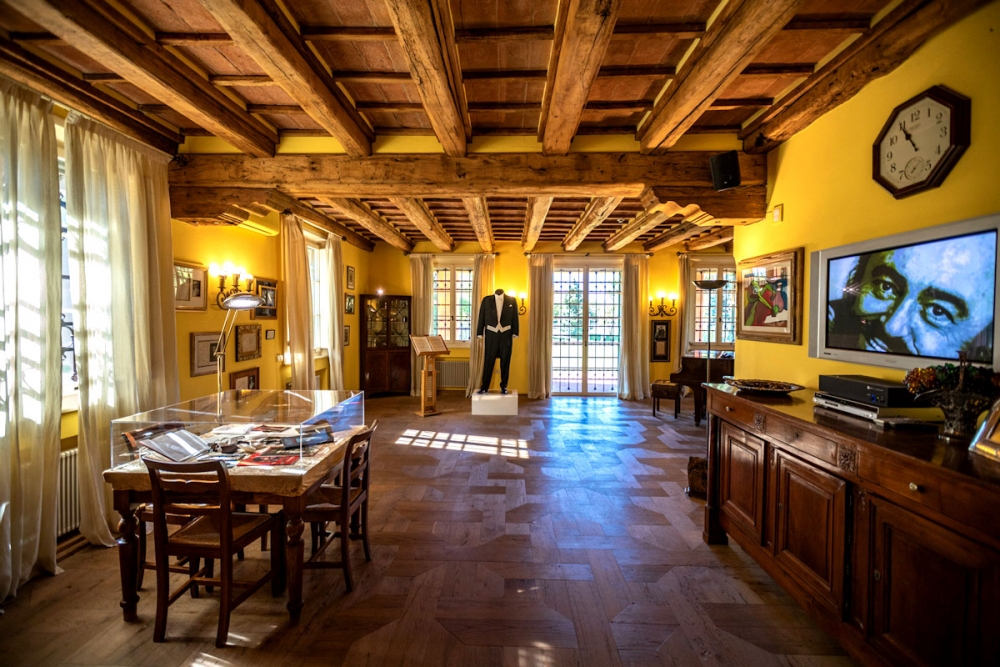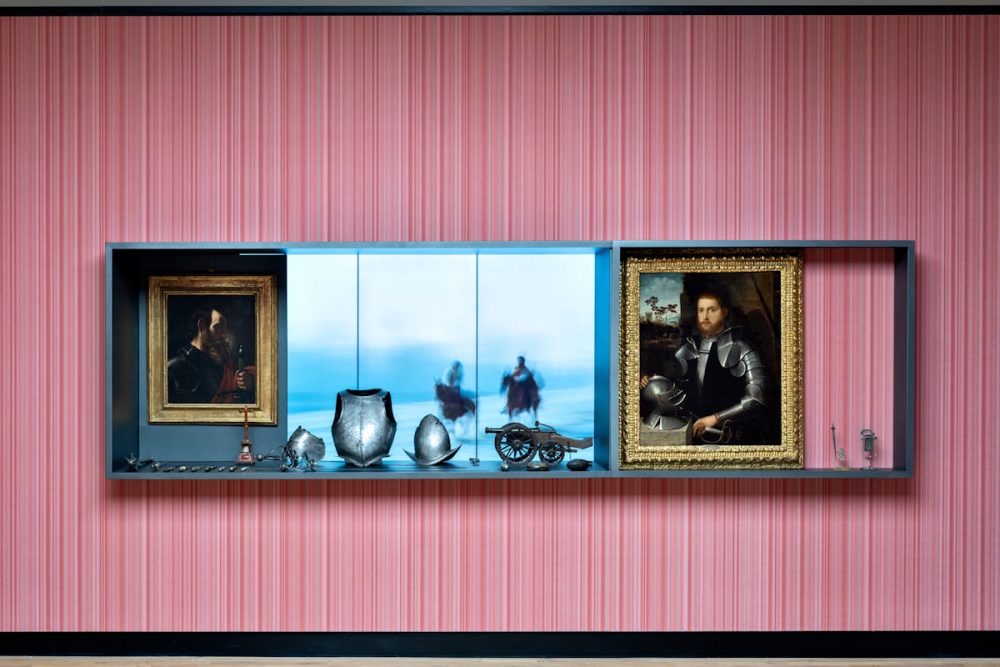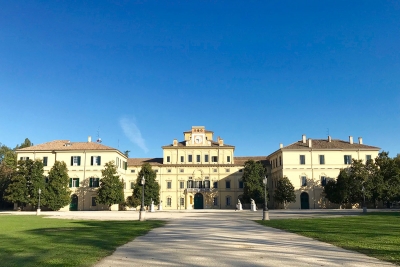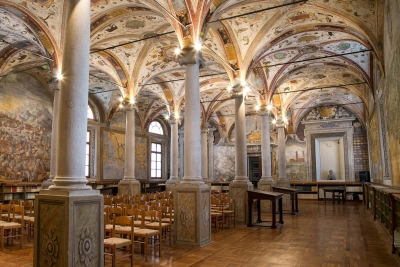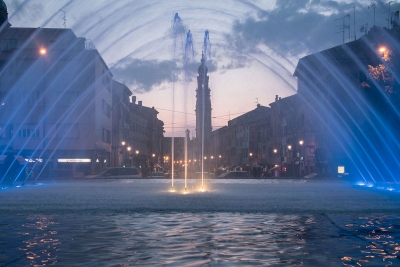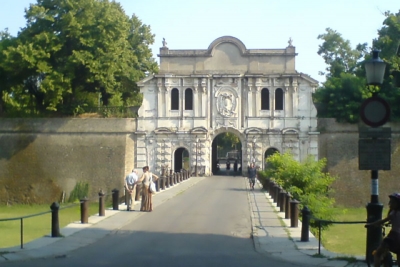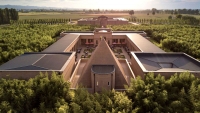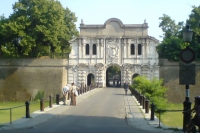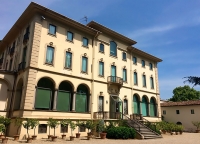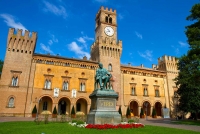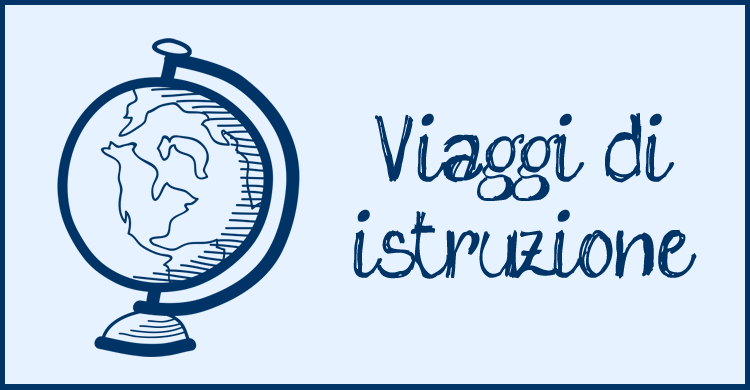The entrance gate is simple. The narrow path leads to a beautiful country house, a solid full of colours structure. Pavarotti’s peaceful retreat in Modena says a lot about him: a famous man deeply anchored to his roots.
At the ground floor his flowery shirts, his deck of cards, his own intense paintings, and his piano welcome us. Pavarotti’s voice is everywhere, singing cheerfully his favourite music.
Upstairs light becomes the protagonist together with the memories and the awards received all over the world.
And more music around, it seems to follow us through the corridors of the house.
In the last room, a bit hidden, a film is projected.
We see images stolen from the daily life of Pavarotti in Modena: so warm with his family and ready to joke with friends ever of a lifetime.
If they were to shoot the Italian version of ‘Night at the Museum’, this would be the appropriate venue. Rhinos, giraffes, lions, stuffed bears seem to be just waiting for the museum doors to be closed to come to life again.
The original nucleus of the Civic Museums of Reggio Emilia began, in fact, with the purchase of Lazzaro Spallanzani's naturalistic collection and expanded following different lines: historical, scientific, and artistic.
There is so much to see, including nineteenth-century and modern lay-outs, all the way to interactive spaces.
Two suggestions: let yourself be amazed by the barbaric Roman treasure and take your time to admire the section dedicated to the Reggio Emilia photographer Luigi Ghirri. Themes that are chronologically distant but representative of the history of Reggio Emilia.
The Grand Tour was a journey through Europe reserved to the descendants of noble and rich families who, in the past centuries, thus perfected their knowledge. Italy was an essential destination and Parma was often part of the itinerary.
Our walking itinerary is a short Grand Tour to discover the great classics of Parma. A journey through its most important monuments such as the Cathedral and the Baptistery, the Palazzo della Pilotta, the facades, the narrow streets and the most beautiful and significant squares in the history of the city, supported by the narration of a local guide.
For those who wish, it is of course possible to enrich the visit with the interiors of the museums or churches that are part of the great artistic heritage of the city.
Suitable for those who do not know Parma and also for those who live there but have never had time for a close contact with the beauty of the place where they live.
A journey through the city's two historic libraries, so different but united by the cultural importance they held in the 16th and 18th centuries. Places of study and reflection that preserve ancient manuscripts and precious volumes, but also authentic caskets of art little known to the public to be rediscovered "with their noses up", letting themselves be guided among symbols and famous people.
In the Library of St. John the Evangelist, located in the silence of the Monastery of St. John the Evangelist, we will discover from the walls to the ceiling a real tangle of emblems and mottos, not easy to decipher today, which indicated to scholars the right way to Knowledge.
In the Palatine Library, located inside the Palazzo della Pilotta and built in 1761 by Don Filippo di Borbone with the help of Paolo Maria Paciaudi "Antiquary and Librarian", we will find a shining example of an Enlightenment-style library, created by the dukes for the benefit of the public.
Have you ever thought about reaching for the stars with the person you love? It’s the opportunity for a unique and unforgettable gift: a guided walk in the historic centre after nightfall, when Parma reveals all its romantic charm. The Cathedral and the Baptistery, Piazza Garibaldi and the Regio Theatre have a thousand stories to tell behind closed doors, in the silence of the evening.
An itinerary of about 2 hours suitable for small groups and families among the main city parks, such as the Ducal Park and the Cittadella Park. The route will also touch the most important monuments of the city centre and places less known by tourists, such as the Church of Santa Croce in Oltretorrente and the Botanical Garden.
Known as the largest in Europe, the Franco Maria Ricci Labyrinth is also an amazing piece of architecture, designed by Pier Carlo Bontempi, and an unusual art collection, the result of the visionary dream of patron and publisher Franco Maria Ricci. The entire structure, container and content, is an expression of his personal taste.
An experience that would not be complete if we were not willing to challenge the bamboo corridors of the Labyrinth, a place where you lose yourself to find yourself again.
A guided walk dedicated to the most evocative views and perspectives of Parma, conceived both for citizens and tourists who love to take pictures in peace and quiet and at the same time wish to learn more about the many faces of the city.
The itinerary is customized and can be carried out at different times of the day, giving the possibility to capture always different lighting and atmospheres.
The Villa dei Capolavori (Masterpieces Villa) of the Magnani-Rocca Foundation, on the hills a few kilometers from Parma, houses the prestigious Luigi Magnani art collection, the subject of our guided tour.
The works include masterpieces by Gentile da Fabriano, Filippo Lippi, Carpaccio, Dürer, Tiziano, Rubens, Van Dyck, Goya and, among the contemporaries, Monet, Renoir, Cézanne, up to De Chirico, De Pisis, Morandi, Burri.
The Foundation also occasionally organizes temporary exhibitions that enrich the guided tour.
For total immersion in Verdi’s places, we can walk in the Master’s steps starting with his birthplace at Roncole and the nearby Church of Saint Michael the Archangel where Verdi was baptised, continuing towards the Verdi Theatre, inaugurated on August 15, 1868, in the Pallavicino Busseto Castle, and the splendid Villa Sant’Agata which preserves intact the rooms containing the Master’s furniture and souvenirs.
For true music enthusiasts, the trip begins in Parma with a Musical Promenade that lets you explore the musical history of the city by choosing these steps: Regio Theatre, Farnese Theatre, Opera Museum, and Arturo Toscanini’s birthplace.
Other significant places, which can be included in a two-day itinerary in Busseto, are:
Casa Barezzi
The Verdi Museum in Villa Pallavicino
The Convent of Santa Maria degli Angeli
More...
Located on a hill overlooking the valley of the Parma Watercourse, this enchanting castle was the scene of the love story between Bianca Pellegrini and Pier Maria Rossi, retraced in the splendid Golden Chamber (about 1460, attributed to Benedetto Bembo).
Set in a pastoral landscape, between vines and the bed of the watercourse, the tour of the castle and the village of Torrechiara plunges us into the Romanesque: it is easy to imagine hearing the hammering of horses’ hooves and the rustle of the lively life of the ladies and knights. To deepen knowledge of the territory, it is possible to tour the Benedictine Abbey of Santa Maria della Neve, the Parma Ham Museum in Langhirano, the wineries and the ham production plants located in the surroundings.
A castle erected in the 14th century and still belonging to the Meli Lupi family, it is one of the most sought after residences in the region and certainly the richest in original furniture and objects.
Nowhere like in Soragna you can breathe the air of an ancient family, rich in history and tradition.
It is advisable to devote a whole day to the village of Soragna to tour, besides the castle, the Synagogue and the Jewish Museum Fausto Levi , the Church of Saint James the Major, the Parmesan Museum and the Museum of Peasant Civilization.
The “Little Versailles of the Dukes of Parma” was the summer residence of the Farnese, Bourbons and Marie-Louise of Austria. Today we can visit the rooms of the noble floor, the private apartment of Duke Ferdinand, the Ducal Chapel of Saint Liborius and the park.
The complex, which is being restored, is of all castles that which is most related to the history of the duchy and the city of Parma. It is rich in histories and anecdotes fed by the personages who lived there, such as the Duchess Babette, the Duke Ferdinand de Bourbon, the Duchess Marie-Louise. Here is a curiosity: did you know that the great fountain of the Ducal Park of Parma used to be in the garden of the Palace of Colorno a century ago? And what destiny had the Palace after the Unity of Italy? Come and discover the reason for this curious move during a tour that will surely surprise you.
Famous for its beautiful moat, the castle that belonged to the Sanvitale houses two jewels: the “Optical Chamber” located in a tower and, on the ground floor, the small room decorated with frescoes of Parmigianino representing scenes from the life of Diana and Actaeon, taken from Ovid’s Metamorphoses. The quintessential 16th-century painting, the remarkable artistic quality of these works and the complexity of their interpretation never ceases to enchant visitors and academics.
To complete the tour, we cannot miss a stroll through the characteristic alleys of the village or having visited the Sanctuary of the Blessed Virgin of the Rosary which dates back to the 17th century and whose 1615 wooden statue of the Virgin has been the subject of great devotion and pilgrimages for more than four centuries.
